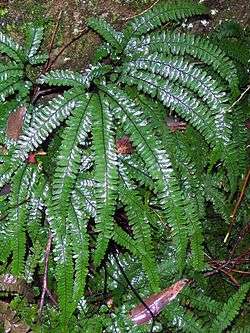Adiantum hispidulum
| Rough Maidenhair Fern | |
|---|---|
 | |
| Maidenhair Fern, Chatswood West, Australia | |
| Scientific classification | |
| Kingdom: | Plantae |
| Division: | Pteridophyta |
| Class: | Pteridopsida |
| Order: | Polypodiales[1] |
| Family: | Pteridaceae[1] |
| Subfamily: | Vittarioideae[1] |
| Genus: | Adiantum |
| Species: | A. hispidulum |
| Binomial name | |
| Adiantum hispidulum Sw. | |
| Synonyms | |
Adiantum hispidulum, commonly known as Rough Maidenhair Fern or five-fingered jack, is a small fern in the family Pteridaceae of widespread distribution. It is found in Africa, Australia, Polynesia, Malesia, New Zealand and other Pacific Islands.[2] Its fronds rise in clumps from rhizomes among rocks or in the soil in sheltered areas.
Taxonomy
Adiantum hispidulum was first described by Swedish botanist Olof Swartz in 1802.[3] Its species name is derived from the Latin hispis "hair" and means "minutely hairy".[4] Five Fingered Jack is an alternate vernacular name.[5]
Description
Adiantum hispidulum grows in tufts or clumps among rocks or from the ground, its fronds arising from the short dark clumped rhizomes. The dark stipe measures up to 45 cm (18 in) in length. The fronds are divided into long and short narrow triangular or elliptic pinnae, each of which is divided again into smaller roughly rectangular, diamond-, or fan-shaped pinnules. Each pinnule may have 1 to 20 sori along its margins underneath. Young growth may have a pinkish tinge before it matures into the dark green foliage.[2][6]
Distribution and habitat
The species ranges from tropical eastern Africa, including South Africa, Mozambique, Malawi, Kenya and Tanzania, as well as Madagascar and the Comoros, Mauritius, to Asia through Malesia to all states of Australia (with the exception of Tasmania[7]), as well as New Zealand and Pacific islands.[8] A common plant, Adiantum hispidulum is often seen growing in moist areas. In Australia it is found near rocks, in rainforest or open forest.[9]
Cultivation
Adiantum hispidulum is grown as an ornamental plant that adapts readily to cultivation, although may be slow growing. It is more tolerant of sun and drying out than other fern species.[4]
| Wikimedia Commons has media related to Adiantum hispidulum. |
References
- 1 2 3 Christenhusz, Maarten J. M.; Zhang, Xian-Chun; Schneider, Harald (2011). "A linear sequence of extant families and genera of lycophytes and ferns" (PDF). Phytotaxa. 19: 7–54.
- 1 2 "Adiantum hispidulum". Flora of Australia Online.
- ↑ "Adiantum hispidulum Sw.". Australian Plant Name Index (APNI), IBIS database. Centre for Plant Biodiversity Research, Australian Government.
- 1 2 Elliot, Rodger W.; Jones, David L.; Blake, Trevor (1985). Encyclopaedia of Australian Plants Suitable for Cultivation: Vol. 2. Port Melbourne: Lothian Press. p. 159. ISBN 0-85091-143-5.
- ↑ Stephanie Haslam (2007). "Adiantum hispidulum". Welcome to Noosa's Native Plants. Retrieved 19 July 2010.
- ↑ Fairley A, Moore P (2000). Native Plants of the Sydney District:An Identification Guide (2nd ed.). Kenthurst, NSW: Kangaroo Press. p. 37. ISBN 0-7318-1031-7.
- ↑ http://www.utas.edu.au/dicotkey/dicotkey/ferns/gAdiantum.htm
- ↑ Verdcourt, Bernard (2002). "Entry for ADIANTUM hispidulum var. hispidulum [family ADIANTACEAE], Flora of Tropical East Africa". JSTOR Plant Science. p. 1. Retrieved 19 July 2010.
- ↑ "Adiantum hispidulum". PlantNET - NSW Flora Online. Retrieved 2010-07-14.